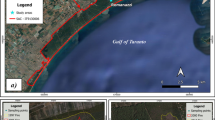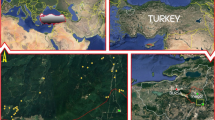Abstract
We studied Nitrogen (N) transformations in Pinus sylvestris forest stands in the foothills of the SE Pre-Pyrenees (NE Spain). Plots were selected in two contrasting aspects (two plots per aspect) and N supply rate was measured by the resin-core incubation technique once every three months. N leaching through litter layers (L and F horizons) was evaluated by 5 zero-tension lysimeters in each plot. NH4 +-N, NO3 --N and soluble organic-N were determined in all solutions. N supply rate showed a clear seasonal pattern. Ammonification and nitrification were segregated in space and in time. While ammonification showed a peak in spring, nitrification was higher in summer. There was evidence suggesting that nitrification occurs mostly in A1 horizon. Nitrification rates differed significantly among plots. N supply rate was 12.7–23.5 kg N·ha-1·yr-1 but it did not differ between aspects or plots. Inorganic-N leached through litter layers was 14–17 kg N·ha-1·yr-1, and represented a high proportion of N supply rate. Organic-N leached through litter layers (27.8–37.0 kg N·ha-1·yr-1) was higher than leached inorganic-N. However, in most cases organic-N did not represent a high proportion of changes in soluble organic-N pools in H and A1 horizons (about 240 kg N·ha-1·yr-1). This large decrease in soluble organic-N was much greater than the increase in inorganic-N. The possible fate of these large amounts of organic-N is discussed.
Similar content being viewed by others
References
Adams J A 1986 Nitrification and ammonification in acid forest litter and humus as affected by peptone and ammonium nitrogen ammendment. Soil Biol. Biochem. 18, 45–51.
Adams M A and Attiwill P M 1986 Nutrient cycling and nitrogen mineralization in eucalypt forests of south-eastern Australia. II. Indices of N mineralization. Plant and Soil 92, 341–362.
Adams M A, Polglase P J, Attiwill P M and Weston C J 1989 In situ studies of nitrogen mineralization and uptake in forest soils; some comments on methodology. Soil Biol. Biochem. 21, 423–429.
Alvera B 1980 Reforno al suelo de materia orgánica y bioelementos minerales en dos bosques altoaragoneses. P. Cent. Pir. Biol. Exp. 12, 55–62.
Bellot J and Escarré A 1991 Chemical characteristics and temporal variations of nutrients in throughfall and stemflow of three species in Mediterranean holm oak forest. For. Ecol. Manage. 41, 125–135.
Binkley D and Vitousek P 1989 Soil nutrient availability in forest soils. Adv. Soil Sci. 10, 58–104.
Binkley D, Bell D and Sollins P 1992 Comparison of methods for estimating soil nitrogen transformations in adjacent conifer and alder-conifer forests. Can. J. For. Res. 22, 858–863.
Bogatyrev L, Jepsen E A, Berg B and Staaf H 1983 Leaching of plant nutrients and total phenolic substances from some foliage litters-A laboratory study. Swedish Coniferous Forest Project Tech. Rep. 33. EMC SLU, Uppsala.
Bottner P 1985 Reponse of microbial biomass to alternate moist and dry conditions in a soil incubated with 14C and, 15N-labelled plant material. Soil Biol. Biochem. 17, 329–337.
Bowen G D and Smith S E 1981 The effects of mycorrhiza on N uptake by plants. In Terrestrial Nitrogen Cycles. Eds. F E Clark and T Roswall. Ecol. Bull. Stockholm. 33, 237–247.
Cortina J and Romanyà J 1992 Nutrient transfer from forest floor to mineral soil in a Pinus radiata D.Don stand. In Responses of Forest Ecosystems to Environmental Changes. Eds. Teller et al. pp. 767–768. Elsevier, London, New York.
DiStefano J and Gholz H L 1986 A proposed use of ion exchange resin to measure nitrogen mineralization and nitrification in intact soil cores. Commun. Soil Sci. Plant Anal. 17, 989–98.
Davidson E A, Eckert R W, Hart S C and Firestone M K 1989 Direct extraction of microbial bicmass nitrogen from forest and grassland soils of California. Soil Biol. Biochem. 21, 773–778.
Duchafour P 1984 Edafologia: I. Edafogénesis y clasificación. Ed. S A Masson. Barcelona, Spain. 493 p.
Escarré A, Gracia C, Roda F and Terradas J 1984 Ecologia del bosque esclerófilo mediterráneo. Inv. Cienc. 95, 68–78.
FAO-UNESCO 1988 Soil map of the world. Revised legend. FAO, Roma. 119 p.
Garcia-Pausas and Fons J 1992 Structure and growth in some topographically differentiated pine forests in Catalonia. Fol. Bot. Misc. 8, 199–213.
Garcia-Pausas J 1993 Litterfall in two Pyrenean stands of Pinus sylvestris L. under different environmental conditions. Fol. Bot. Misc. 9, 127–136.
Helmisaari H S 1990 Temporal variation of nutrient concentrations of Pinus sylvestris needles. Scand. J. For. Res. 5, 177–193.
Helmisaari H S 1992 Nutrient translocation in three Pinus sylvestris stands. For. Ecol. Manage. 51, 347–367.
Hossain A K M A 1993 Acid-peroxide digestion procedure for determining total nitrogen in chloroform-fumigated and non-fumigated soil extracts. Soil Biol. Biochem. 25, 967–969.
Keeney D R 1990 Prediction of soil nitrogen availability in forest ecosystems: A literature review. For. Sci. 26, 159–171.
Killham K 1990 Nitrification in coniferous forest soils. Plant and Soil 128, 31–44.
Lundeberg G 1970 Utilization of various nitrogen sources, in particular bound soil nitrogen, by mycorrhizal fungi. Studia Forestolia Suecica 79, 1–95.
Mayor X and Rodà F Effects of irrigation and fertilization on stem diameter growth in a mediterranean holm forest. For. Ecol. Manage. (submitted).
Pastor J, Aber J, McClaugherty C and Melillo J 1984 Aboveground production and N and P along a nitrogen mineralization gradient on Blackhawk Island, Wisconsin. Ecology 65, 256–268.
Powers R F 1984 Estimating soil nitrogen availability through soil and foliar analysis. In Forest Soils and Treatment Impacts. Ed. E AStone. Proceedings of the Sixth North American Conference, June 1983. The University of Tennessee, Knoxville.
Qualls R G and Haines B L 1991 Geochemistry of dissolved organic nutrients in water percolating through a forest ecosystem. Soil Sci. Soc. Am. J. 55, 1112–1123.
Raison R J, Connell M J, Khanna P K and Falkiner P K 1992 Effects of irrigation and nitrogen fertilisation on fluxes of soil mineral nitrogen in a stand of Pinus radiata. For. Ecol. Manage. 52, 43–64.
Read D J 1983 The biology of mycorrhiza in the Ericales. Can. J. Bot. 61, 985–1004.
Robertson G P and Vitousek P M 1981 Nitrification in primary and secondary succession. Ecology 62, 376–386.
Rosen K and Lundmark-Thellin A 1987 Increased nitrogen leaching under piles of slash—A consequence of modern harvesting techniques. Scand. J. For. Res. 2, 21–29.
Schimel J P, Firestone M K and Killham K 1984 Identification of heterotrophic nitrification in a Sierra forest soil. Appl. Environ. Microbiol. 48, 802–806.
Sollins P and McCorinson F M 1981 Changes in solution chemistry after clearcutting in an old-growth Douglas-fir watershed. Water Resour. Res. 1409–1418.
Sollins P. CromackJr, McCorinson F M, Waring R H and Harr R D 1981 Changes in nitrogen cycling at an old-growth Douglas Fir site after disturbance. Environ. Qual. 10, 37–42.
Stevens P A and Wannop C P 1987 Dissolved organic nitrogen and nitrate in an acid forest soil. Plant and Soil 102, 137–139.
Stribley D P and Read D J 1980 The biology of mycorrhiza in the Ericaceae VII. The relationship between mycorrhizal infection and the capacity to utilice simple and complex nitrogen sources. New Phytol. 86, 365–371.
Swank W T and Waide J B 1980 Interpretation of nutrient cycling research in a management context: evaluating potential effects of alternative management strategies on site productivity. In Forests: Fresh Perspectives From Ecosystem Analysis. Ed. R HWaring. pp 137–158. Oregon State University Press, Corvallis, Oregon, USA.
VanCleve K and White R 1980 Forest-floor nitrogen dynamics in a 60-year-old paper birch ecosystem in interior Alaska. Plant and Soil 54, 359–381.
Vitousek P M and Melillo J M 1979 Nitrate losses from disturbed forest: patterns and mechanisms. For. Sci. 25, 605–619.
Williams B L 1983 Nitrogen transformations and decomposition in litter and humus from beneath closed cannopy Sitka spruce. Forestry 56, 17–32.
Williams B L 1992 Nitrogen dynamics in humus and soil beneath Sitka spruce (Picea sitchensis (Bong.) Carr.) planted in pure stands and in mixture with Scots pine (Pinus sylvestris L.). Plant and Soil 144, 77–84.
Zou X, Valentine D W, SanfordJr R and Binkley D 1992 Resin-core and buried-bag estimates of nitrogen transformations in Costa Rican lowland rainforests. Plant and Soil 139, 275–283.
Author information
Authors and Affiliations
Rights and permissions
About this article
Cite this article
Casals, P., Romanyà, J., Cortina, J. et al. Nitrogen supply rate in Scots pine (Pinus sylvestris L.) forests of contrasting slope aspect. Plant Soil 168, 67–73 (1995). https://doi.org/10.1007/BF00029314
Issue Date:
DOI: https://doi.org/10.1007/BF00029314




